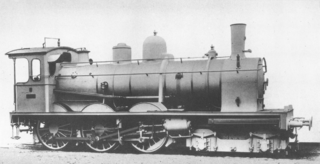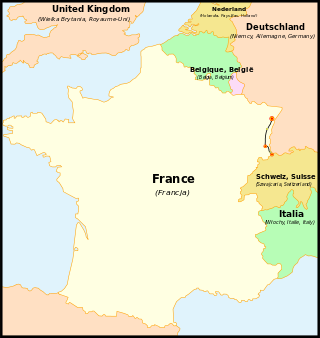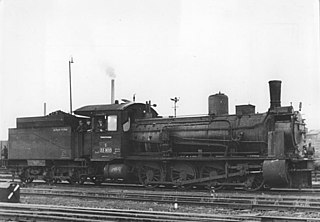
The history of rail transport in France dates from the first French railway in 1823 to present-day enterprises such as the AGV.

The Compagnie des chemins de fer de l'Est, often referred to simply as the Est company, was an early French railway company. The company was formed in 1853 by the merger of Compagnie du chemin de fer de Paris à Strasbourg, operating the Paris-Strasbourg line, and Compagnie du chemin de fer de Montereau à Troyes. In 1938 it became part of the majority state-owned Société Nationale des Chemins de fer Français (SNCF).

Transport express régional is the brand name used by the SNCF, the French national railway company, to denote rail service run by the regional councils of France, specifically their organised transport authorities. The network serves French regions; Île-de-France (Transilien) and Corsica (CFC) have their own specific transport systems. Every day, over 800,000 passengers are carried on 5,700 TER-branded trains.

The Kaiserliche Generaldirektion der Eisenbahnen in Elsaß-Lothringen or EL were the first railways owned by the German Empire.
The Prussian G 12.1 was a German steam locomotive built for the Prussian state railways during the First World War and was the largest Prussian freight locomotive with a 2-10-0 wheel arrangement. It had three cylinders, the two outer ones driving the third axle and the inner one the second axle.

The Prussian T 16.1 locomotives were built for the Prussian state railways as goods train tank locomotives about the time of the First World War. Six examples were also procured by the Imperial Railways in Alsace-Lorraine.

The locomotives of Baden Class IV e were designed and built for the Grand Duchy of Baden State Railway in the late 19th century by the Elsässischen Maschinenbau-Gesellschaft Grafenstaden, who supplied the first eight examples in 1894. They were the first locomotives in Germany with a 4-6-0 wheel arrangement. Another 75 locomotives were built up to 1901 by the Maschinenbau-Gesellschaft Karlsruhe.

The railway from Paris-Est to Strasbourg-Ville is a 493-kilometre-long railway line that connects Paris to Strasbourg via Châlons-en-Champagne and Nancy, France. Officially, the line does not start at the Gare de l'Est in Paris: the first 9 km until Noisy-le-Sec is shared with the railway from Paris to Mulhouse. The railway was opened in several stages between 1849 and 1852. The opening of the LGV Est high speed line from Paris to Baudrecourt in Lorraine in 2007 has decreased the importance of the section Paris–Sarrebourg for passenger traffic.

The railway from Strasbourg to Basel is a French and Swiss 141.3-kilometre long railway line. It is used for passenger and freight traffic. The railway was opened in 1840–1844. It was the first railway line to serve Switzerland.
The Rothschild Bank founded the Société Anonyme de Gérance et d'Armement in 1919 for the management of French state-owned ships.

The history of rail transport in Luxembourg began in 1846 and continues to the present day.

Saverne station is a French railway station located on the Noisy-le-Sec–Strasbourg railway. It is located within the commune of Saverne, in departement Bas-Rhin, in northeastern France.

The Prussian T16 locomotives were ten-coupled superheated freight tank locomotives of the Prussian State Railways. They were later renumbered in the 94.2–4 by Deutsche Reichsbahn

Lauterbourg station is a railway station in the town of Lauterbourg in the département of Bas-Rhin in the French region of Grand Est.
Alsace-Lorraine A 1 was a class of two express passenger 2-4-0 steam locomotives of the Imperial Railways in Alsace-Lorraine (Reichseisenbahnen in Elaß-Lothringen) that were acquired in 1871. They were in service until they were retired in 1900 and 1904.

The Prussian G 7.2 was a class of 0-8-0 tender compound locomotives of the Prussian state railways. In the 1925 renumbering plan of Deutsche Reichsbahn, the former Prussian locomotives produced from 1895 to 1911 were given the class designation 55.7–13; while the locomotives of former Mecklenburgische Friedrich-Franz-Eisenbahn (MFFE) locomotives were classified as 55.57.
The Prussian G 5.2 was a class of two-cylinder compound goods locomotive introduced in 1895. As with many Prussian locomotive design, simple and compound versions of the same type were built – in this case the G 5.2 was the two-cylinder compound version of the simple G 5.1. The compound locomotives were more economical and more powerful than the simple locomotives; they were more suitable for long stretches with few stops. The newly introduced air brakes made it possible to use the G 5.2 on passenger trains, which the Prussian State Railways often did.

In France, the Réseau Ferré National (RFN) is made up of railroad lines and infrastructure belonging to the French state, and assigned to SNCF Réseau.
The Société royale grand-ducale des chemins de fer Guillaume-Luxembourg or "Royal Grand Ducal William-Luxembourg Railway Company", was a Luxembourgish company, with French capital, created in 1857 to operate the 1855 concessions for the railway lines in the Grand-Duchy of Luxembourg. It constructed a set of lines that made up the railway network called the Guillaume-Luxembourg network. It was never an operating company, transferring this activity to a French company, the Compagnie des chemins de fer de l'Est, then to the Imperial Railways in Alsace-Lorraine in 1872, to the Administration des chemins de fer d'Alsace et de Lorraine in 1919, and then to the SNCF in 1938. During the German occupation in World War II, the Deutsche Reichsbahn operated the network until the liberation; the Guillaume-Luxembourg company ceased to exist as such in 1946 with the creation of the Société nationale des chemins de fer luxembourgeois.
This page is based on this
Wikipedia article Text is available under the
CC BY-SA 4.0 license; additional terms may apply.
Images, videos and audio are available under their respective licenses.














